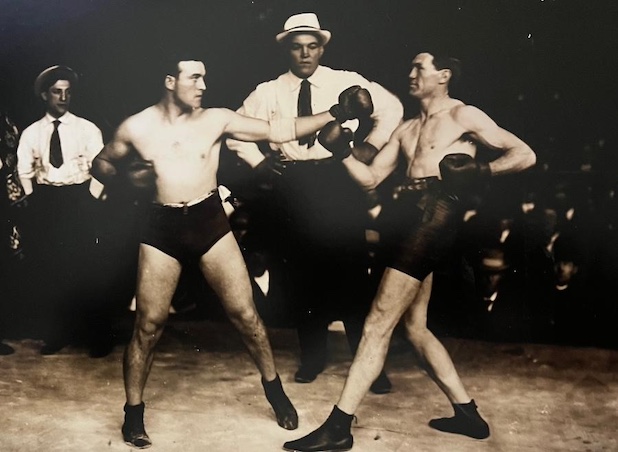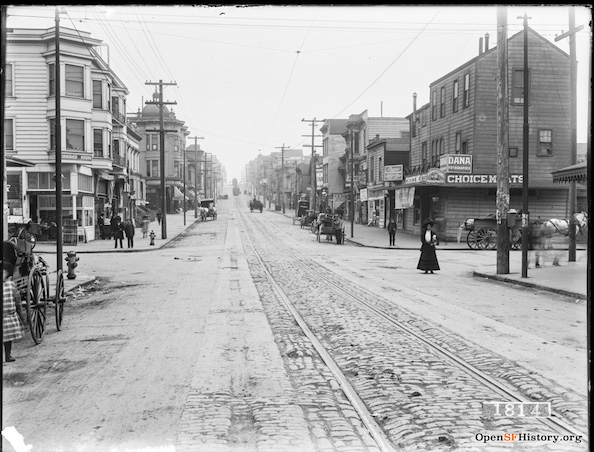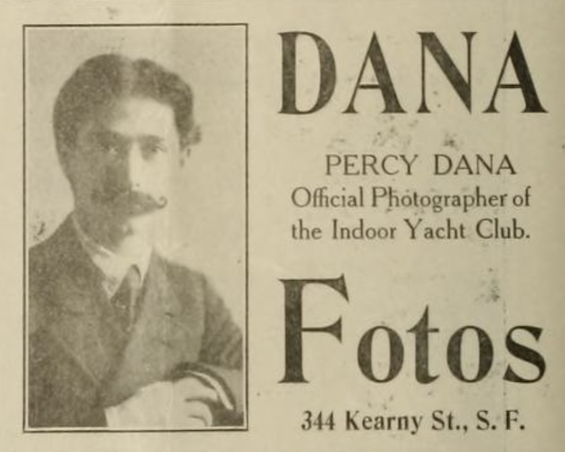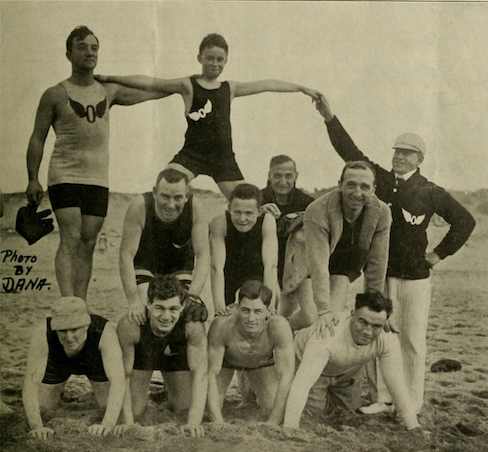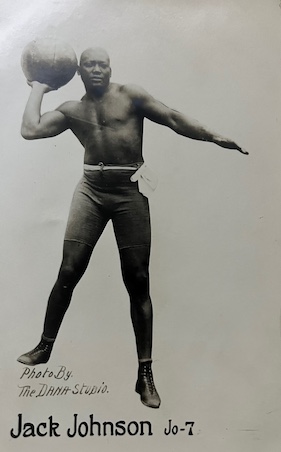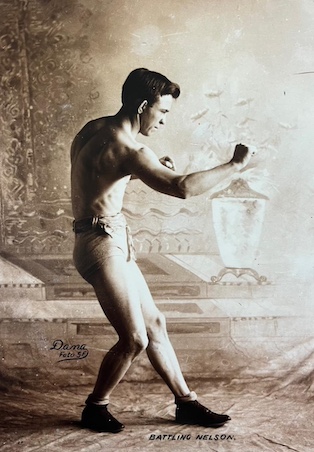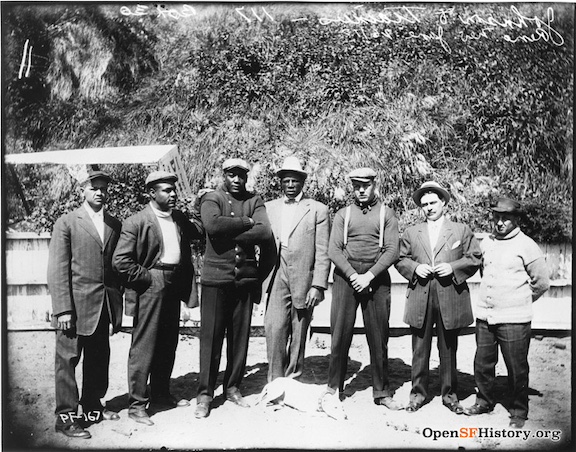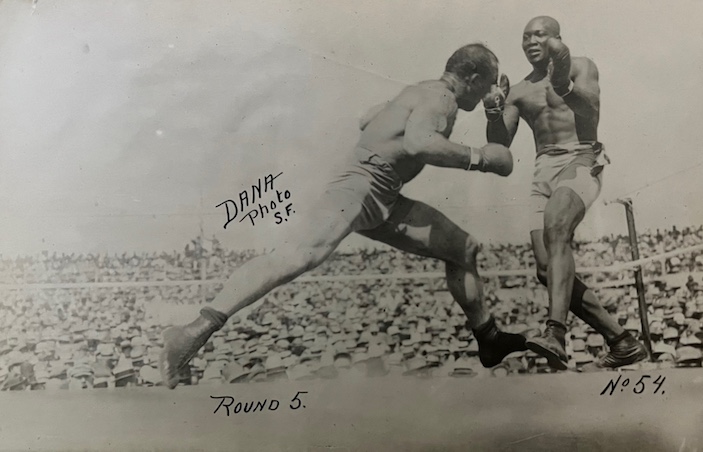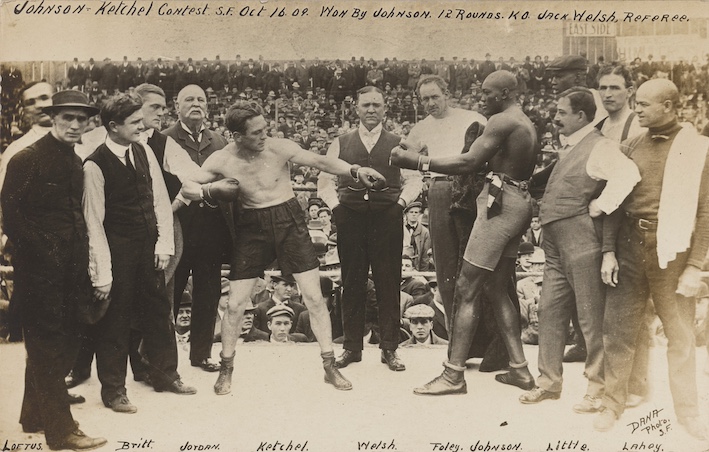Percy Dana, Boxing Photographer
Historical Essay
by Eva Knowles, 2024, with research contributions from Howard Ruff and Steven Schutzman
Tommy Burns, the Heavyweight Champion, defending his title against Philadelphia Jack O'Brien, the recent Light Heavyweight Champion of the World, in Los Angeles on November 28, 1906. Between them is former Heavyweight Champion James J. Jeffries.
Photo: Percy Dana. Personal collection of Howard Ruff.
| San Francisco-based photographer Percy Dana is renowned for his photographs of some of the most famous boxers and boxing matches of the early twentieth century. His work was incredibly popular at a time when San Francisco was the breeding ground for some of the most important boxers in history. This history is drawn from available information on Dana. |
Famous sports photographer Percy Dana moved to San Francisco from the midwest in the late nineteenth century. Because Percy Dana was also referred to as Parsons Dana, Charles Percy Dana, and P. F. Dana, it is difficult to trace his early life. There is evidence to support two possibilities for Dana's birth and family. Newspapers and census records from Kansas place a Parsons Dana as being born on March 16, 1871 in the town of Parsons. His parents were William W. and Nancy Dana; his father was born in New Hampshire and was a civil war veteran. Dana was the first child born in Parson, a railroad town, and was given land by the town president because of that. Other evidence, including San Francisco newspapers and marriage records, supports Dana's birth as occurring in Missouri in 1873. According to an 1895 article in the San Francisco Call, a 22-year-old Percy Dana worked opening the doors at the Occidental Club. At the time, the Occidental Club was a social-political organization that rallied supporters of the “Blind Boss” Christopher Buckley, a Democratic political boss. The Call article reads: “His father used to be a big stock dealer in Missouri, and supplied mules to the Government… Percy drifted out here, went into the grocery business out on Bush street, opposite Buckley's City residence. He bought tea and coffee off John McCarthy and sold it to Buckley. Both liked him, and when the grocery business became bad a few months ago he became assistant steward of the Occidental Club.” Future historians may resolve this mystery over Dana's early life.
Ellis and Webster in 1908. P.F. Dana photo studio, 1487 Ellis, at right.
Photo: OpenSF History / wnp60.0050
Dana's photography career started around the turn of the century. What appears to be his first credited photograph was in the San Francisco Examiner in 1900. Throughout the next few decades, Dana moved between a number of locations:
- 1901: Dana ran McKinley’s Photo at 632 Market Street.
- 1904: Multiple ads in the Recorder between April and October 1904 list Dana and C. L. Petersen of Backus Studio at 44 Geary St.
- 1906: The San Francisco Call lists Dana & Towers at 1487 Ellis Street. 1907-08 motor vehicle registration confirms this address for Dana.
- 1908: Dana purchased land in Livermore. This was likely during a trip he took with boxer Battling Nelson, reported on by the San Francisco Call, to a Livermore vineyard that Nelson planned to purchase.
- By 1910, he had opened the Dana Studio, which the San Francisco directory for that year lists at 1354-1356 Fillmore: “DANA STUDIO, commercial photography, documents photographed or anything copied, kodak developing and printing, kodaks loaned.”
- 1911-13: The studio had moved to 344 Kearny St. by 1911 according to a want ad in the San Francisco Examiner and the Indoor Yacht Club’s Main Sheet.
- 1915: The San Francisco directory lists Dana at 1035 Market Street.
- 1916: A want ad in the San Francisco Chronicle from April 29 lists his studio at 1003 Golden Gate Avenue; California voter registration lists him at the same address and as a Democrat.
An advertisement in the Indoor Yacht Club’s Main Sheet, 1911.
Dana served as the official photographer of the Indoor Yacht Club (IYC), a men’s club whose members included many prominent San Franciscans of the era. Contrary to its name, the club had nothing to do with boats and in fact avoided them per its bylaws. In addition to regular events such as dinners, the club often hosted trips via train or car for its members, upon which Dana would photograph the day’s events. He is advertised by the IYC as having a complete photo studio set up aboard the organization’s trains, and a 1911 issue of the IYC’s Main Sheet describes Dana as planning to turn a baggage car into a darkroom onboard a train to the Sierras. He photographed not only members but also produced various panoramic shots.
An IYC group on Ocean Beach, from the Main Sheet. Marked “Photo by Dana.”
The Dana Studio was also the official photographer for the 1911 Fraternal Order of Eagles Convention, where Dana had a contract to do souvenir postcards with the Eagles Grand Aerie. This aligns with the growing popularity of postcards at this time; many of the fights that Dana photographed also produced postcards.
Jack Johnson, Heavyweight Champion of the World, on a 1910 postcard.
Photo: Percy Dana. Personal Collection of Howard Ruff.
Dana was credited frequently in San Francisco newspapers for his photographs and was often described as one of the Bay Area’s leading photographers, as well as as the official photographer for larger fights. The boxers he photographed included Jack Johnson, Jim Jeffries, Stanley Ketchel, Jim Flynn, Ad Wolgast, Tommy Burns and Joe Gans. His photographs appeared in the San Francisco Call, the San Francisco Call and Post, the San Francisco Bulletin and the San Francisco Examiner. He is credited with many photos that were not boxing related as well.
Battling Nelson, World Lightweight Champion, in 1909.
Photo: Percy Dana. Personal Collection of Howard Ruff.
Dana played a variety of other roles in the boxing world besides being a photographer. The Examiner credits him as being a boxing match reporter. In 1905, Dana refereed a preliminary match between George Baker and Jim Kane. In Battling Nelson’s autobiography, Dana is listed as an assistant to Nelson in his fight with Joe Gans on July 4, 1908. A San Francisco Chronicle article from December 4, 1914 describes Dana as managing the boxer Bill Sloane.
Jack Johnson and trainers at Johnson's training camp at Seal Rock House on Ocean Beach, 1910.
Photo: Percy Dana. Courtesy of OpenSF History / wnp4/wnp4.0918
Boxing had gained a strong foothold in the Bay Area as early as the Gold Rush, and by the early 1900s San Francisco was one of its global capitals; boxing historian Burt Sugar describes the city as “THE hub of boxing.” High-profile boxing matches brought thousands of spectators, and professional boxing clubs around the city trained some of the biggest names of the sport. As a photographer, Dana’s legacy includes leaving behind visible traces of these matches and athletes.
Jack Johnson versus James J. Jeffries at the Heavyweight title fight on July 4, 1910, for which Dana Studio was the principal photographer.
Photo: Percy Dana. Personal Collection of Howard Ruff.
One of the most famous fights for which he was the official photographer was the “Fight of the Century” between Jack Johnson and James Jeffries on July 4, 1910, as well as the training camps beforehand. Nine cameramen filmed the fight. However, films of the fight were soon banned by many states and cities, and in 1912 Congress banned them from crossing state lines. The ban wasn’t lifted until 1940—meaning that Dana’s photography provided the only access to images of the event.
Boxing was not the only sport he dipped his toes into. A 1912 Chronicle article reports that a temporary restraining order was filed against Dana for his attempts to photograph baseball players of the Pacific Coast League. Another photographer, Joseph E. Derham, claimed that he had been given exclusive rights to photograph members of the team.
In 1913, Dana married an Austrian woman named Dora Perz, age 29, in Santa Rosa, a town he apparently visited frequently. Later census records show that they had a daughter Betty and adopted another, Dolores, who may have been Perz’s biological daughter. Dolores died in a house fire in 1944.
Dana was nicknamed “Bird-Seed” and “Pee Wee” for his small stature. A Chronicle article highlighting old boxing matches, published on February 5, 1933, describes him this way: “Just before Nelson and Attell started their 15-round draw at the Coliseum arena, they posed for the customary picture with Pee Wee Percy Dana, the photographer, who wasn’t half way as tall as his tripod.” Another Chronicle article, published on October 3, 1940, echoes the description: “A veteran photographer, ‘Pee Wee’ (Percy) Dana, who was about as big as a canary, and had a long, flowing mustache, always took [posed photos of boxers before their fights] and his widow had a remarkable collection.”
By the mid-1910s, there was limited work in boxing photography and the boxing arena in general. In 1914, California voters approved an amendment that severely restricted professional boxing to “amateur matches,” with a maximum of four rounds and a maximum prize of $25 per boxer. Hall of Fame promoter James Coffroth, then considered one of the most important men in the sport, left the Bay Area at this time for Tijuana, Mexico for its lack of reformist restrictions, where he opened a horse track. Dana, too, left San Francisco for Los Altos, where San Jose City and Santa Clara directories list him as a rancher between 1922 and 1940. Voter registration lists him as a farmer between 1932 and 1944. He died in 1950.
Johnson-Ketchel Contest in San Francisco on October 16, 1909.
Photo: Ross J. Kelbaugh Collection, Purchased by the National Gallery of Art with support from the Ford Foundation.
As a further indication of his important legacy, in 2023, the National Gallery of Art purchased one of Dana’s images, included above.

